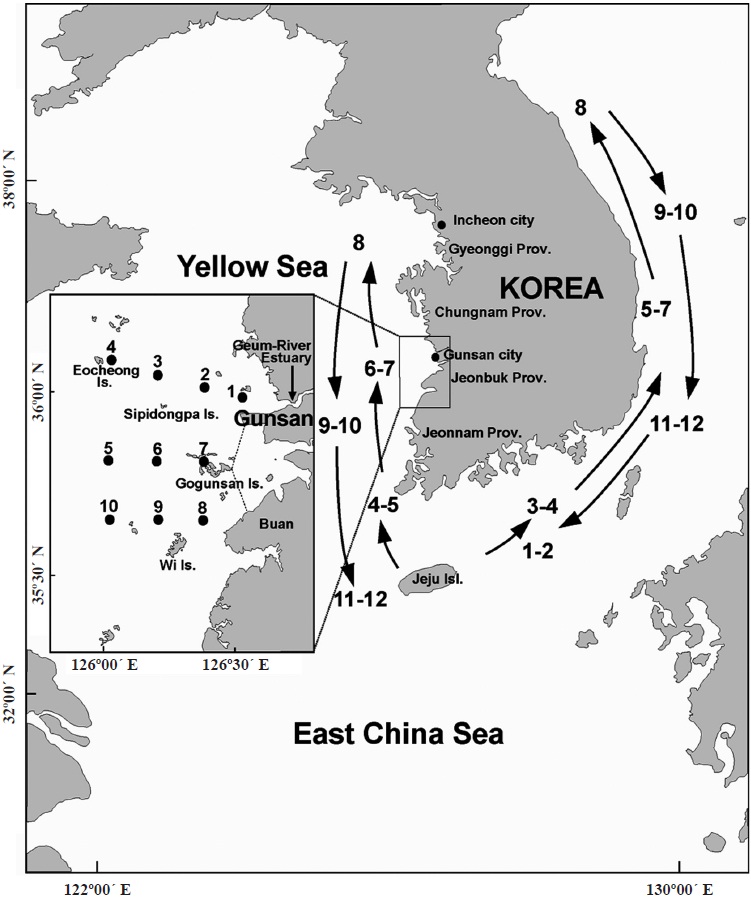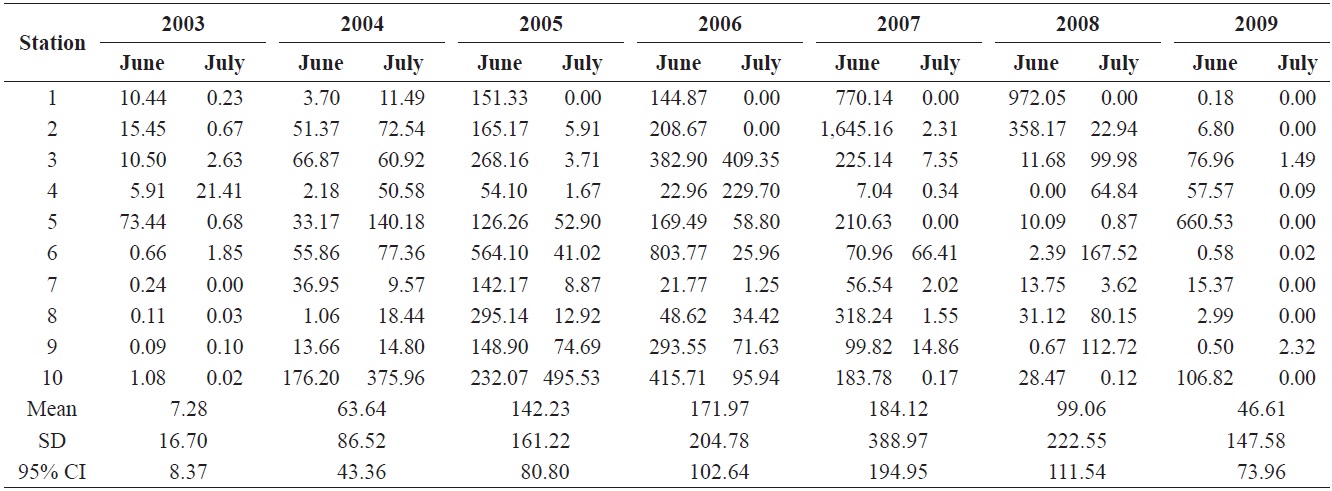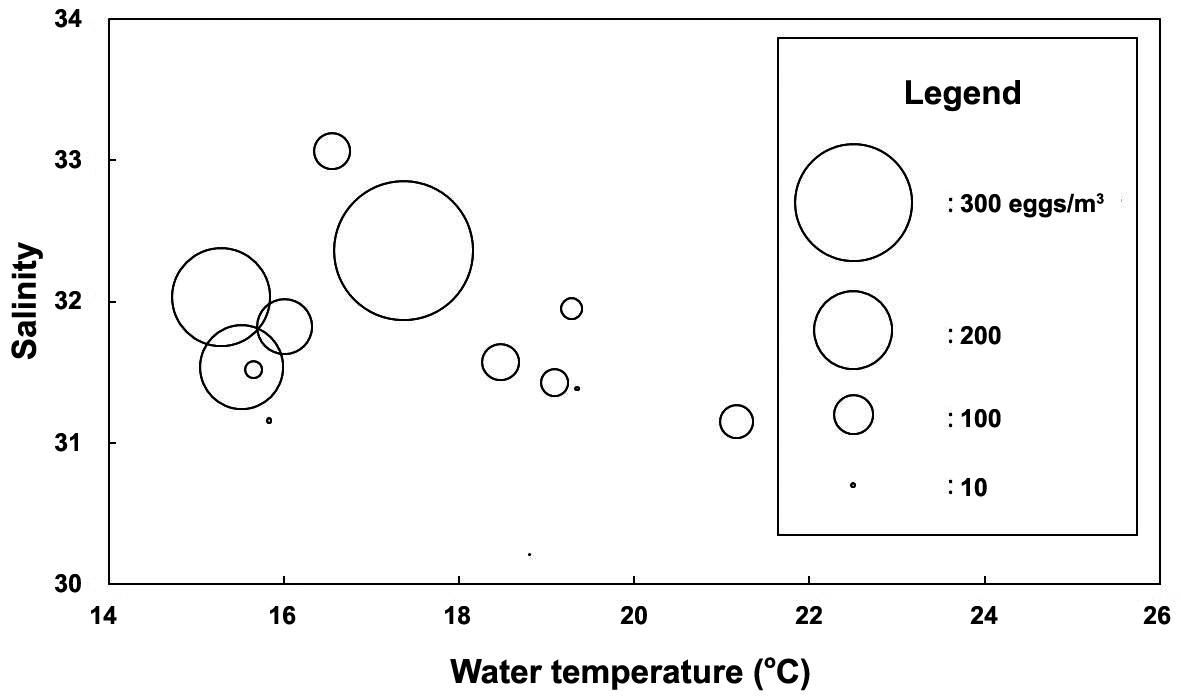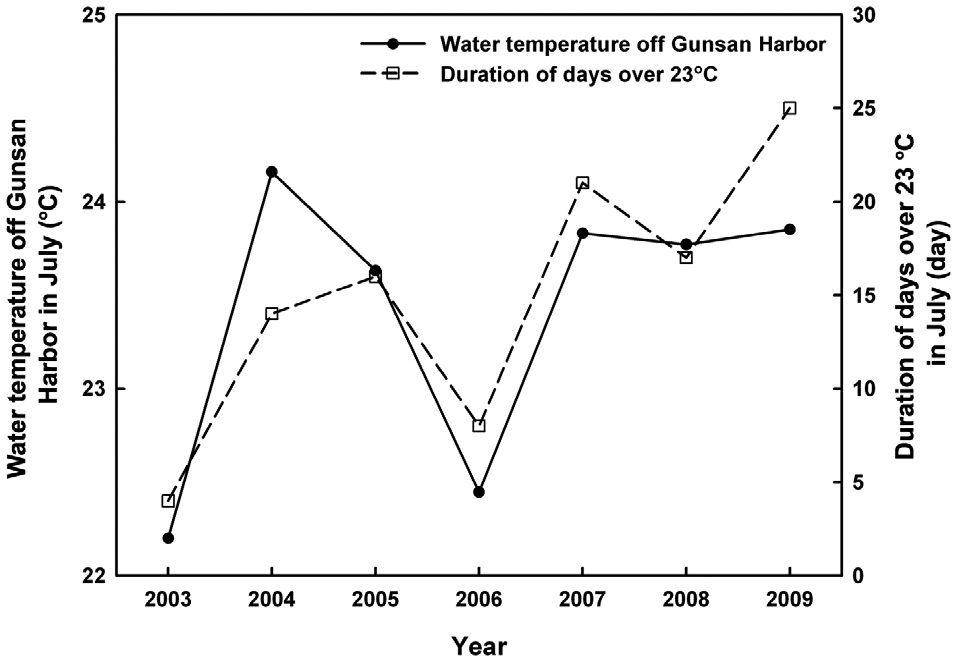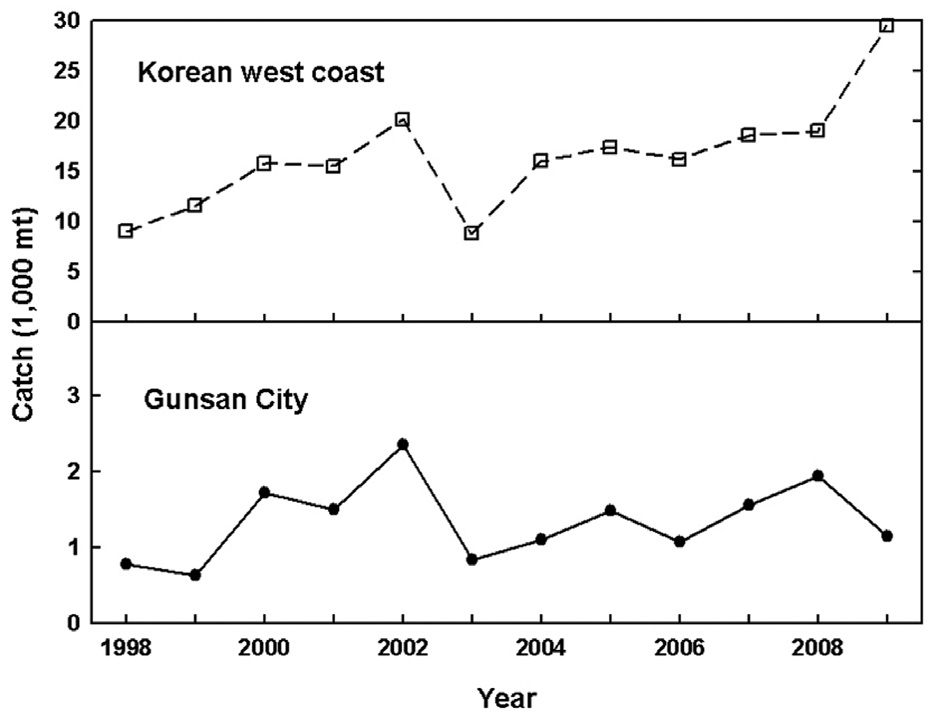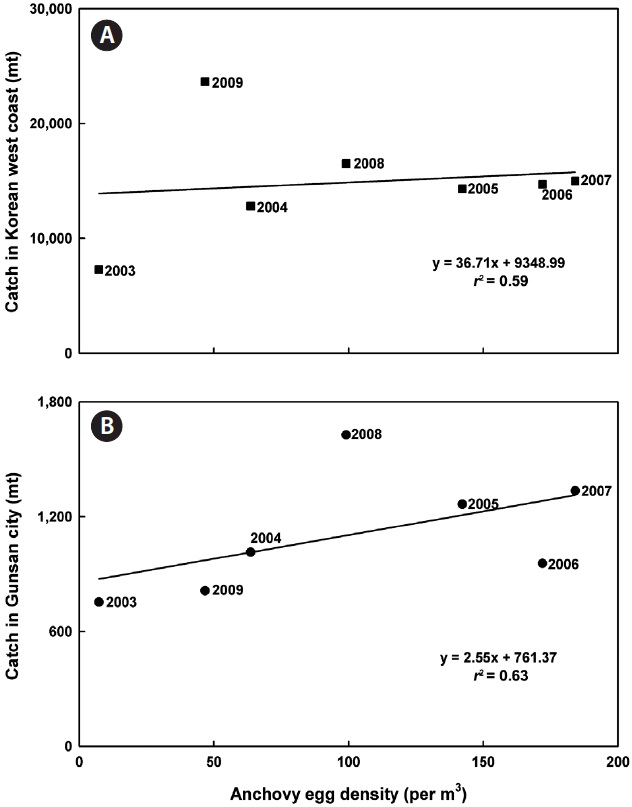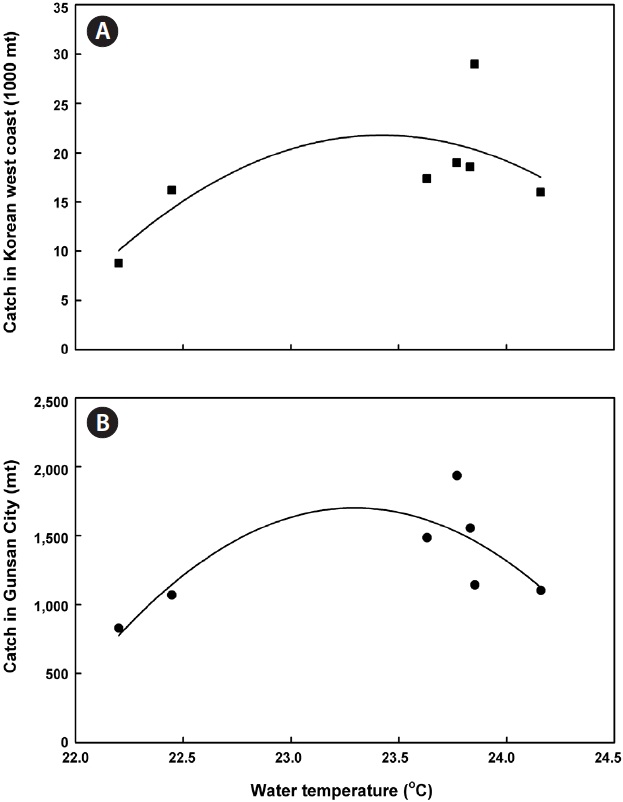



To predict catches of Pacific anchovy Engraulis japonicus larvae, anchovy eggs were collected in the coastal waters off Gunsan, Korea, in the Yellow Sea during the main spawning season (June to July) from 2003 to 2009. A ring net was repeatedly towed vertically at 10 stations during the daytime to sample eggs. Catch data estimated by auction sales were obtained from the Fisheries Cooperatives Union of Gunsan City and daily water temperature data in the outer harbor of Gunsan City during the survey periods were obtained from the National Oceanographic Research Institute. A significant relationship was found between anchovy egg density from June to July and larval catch from July to October in the same year. Catch of anchovy larvae in Gunsan were also high when optimal growth temperatures were recorded in the coastal waters off Gunsan in July. Although the recruitment success or failure of anchovy larvae can be predicted from variability in egg density, we suggest that mean daily water temperature is a more efficient indicator for predicting variability in catches of larval anchovy in the Yellow Sea.
Over the last few decades, the major fishery species in the Yellow sea have changed from large demersal fishes that occupy high trophic levels to small pelagic species that occupy low trophic levels (Kim, 1983b; Hwang et al., 2001). This change may have occurred as a result of the overfishing of commercially valuable large fishes.
Pacific anchovy
Pacific anchovy larvae have traditionally been used as a fishery resource in the northern East China Sea (
Pacific anchovy reside in the northern East China Sea in winter (NFRDI, 2005), and migrate northwestward to the west coast of Korea in the Yellow Sea to spawn in spring and summer (Kim, 1983a; Cha, 1990; Hwang et al., 2006). Anchovy mainly spawn from June to July, although eggs occur when
water temperatures are 17-27℃ during May-September along the west coast of Korea in the Yellow Sea (Hwang et al., 2006, 2007). After spawning, Pacific anchovy disperse into the central part of the Yellow Sea to feed and migrate southward to overwinter (Iversen et al., 1993). On the west coast of Korea, anchovy can be expected to be distributed off Jeonnam Province in April-May, Jeonbuk and Chungnam provinces in June-July, and Gyeonggi Province and the Incheon megalopolis in August, in accordance with their northward migration along the west coast of Korea. They migrate southward to the waters off Jeonbuk and Chungnam provinces in September-October and overwinter off Jeonnam Province and around Jeju Island after November (Fig. 1, modified from Hwang et al., 2007). Water temperature probably affects the spawning rate and growth of anchovy in the eastern Yellow Sea (Hwang et al., 2006, 2007), and growth during the early life stage of Pacific anchovy in Japanese Pacific coastal waters is thought to follow a simple “optimal growth temperature” hypothesis (Takasuka et al., 2007).
Large fluctuations in recruitment may be influenced by subtle variation in mortality rates, growth rates, or the durations of early life stages in fishes (Houde, 1987, 1989). Variability in survival rates in early life stages affects recruitment levels and spawning-stock biomass in bay anchovy (Dorsey et al., 1996). Strong relationships have also been found between Spanish mackerel juvenile abundance and catch per unit effort of 1-year-old Spanish mackerel (Shoji and Tanaka, 2003).
Oceanographic conditions affect survival rates in all life stages, but this is particularly true in early life stages (Cushing, 1975; Lasker, 1981; Rutherford and Houde, 1995; Takahashi et al., 2009; Takasuka et al., 2003, 2004). Annual variation in recruitment conditions and the subsequent survival of anchovy larvae in the Yellow Sea can be influenced by variability in oceanic conditions. However, despite the commercial importance of anchovy, little research has examined recruitment variability in this species.
The objective of this study was to determine the relationship between egg density and larval catch in the Yellow Sea along the west coast of Korea. We also investigated relationships between oceanographic conditions and catches of anchovy larvae. These results will improve our ability to predict catches of Pacific anchovy larvae in the Yellow Sea.
Egg surveys were conducted at 10 stations in the Yellow Sea off Gunsan City in Jeobuk Province aboard the
Water temperature and salinity were measured at the sampling locations using a handheld multi-parameter instrument (YSI-556; YSI Inc., Yellow Springs, OH, USA). We averaged the water temperature and salinity measurements in the surface and bottom layers at each station because eggs were collected by vertical tows and the water column was well mixed. We also used daily surface water temperature data that were collected by the Korea Hydrographic and Oceanographic Administration (KHOA, 2003-2009) in the outer harbor of Gunsan City in July 2003-2009.
We used “sales slip catch data” from the Fisheries Cooperatives Union of Gunsan City and catch statistics for anchovy on the Korean west coast in the Yellow Sea, including values from Jeonbuk, Chungnam, and Gyeonggi provinces, and the Incheon megalopolis (hereafter referred to as the “Korean

Annual egg density (inds/m3) of Pacific anchovy collected at 10 stations off Gunsan City in Jeonbuk Province in the Yellow Sea during June-July from 2003 to 2009
west coast”), based on the Annual statistics on cooperative sales of fishery products (National Federation of Fisheries Cooperatives, 1998-2009). Sales slip catch data and catch statistics were reported as dry weights because Korean fishermen steam and dry small anchovy immediately after they are caught. In 2008, the anchovy catch flowed into Gunsan City from neighboring cities because high prices were being paid in Gunsan, where there is a traditional fish market for anchovy (Fisheries Cooperatives Union, personal communication). In 2009, the anchovy catch from the Korean south coast was sold on the Korean west coast, where prices were higher due to the closer proximity to metropolitan areas (Fisheries Cooperatives Union, personal communication). For these reasons, recorded catches from 2008 in Gunsan city and 2009 on the Korean west coast may be outliers and were omitted from our statistical analyses.
Relationships between larval catch data and egg density and oceanographic parameters were estimated using Pearson’s correlation coefficients and linear regression using PROC REG in SAS version 9.1 (SAS, 2004). Anchovy mainly spawn in June-July and grow to larvae and juveniles in July-October. Thus, relationships between anchovy egg density in June-July and larval catches at Gunsan City and on the Korean west coast in July-October were analyzed.
>
Annual fluctuations in anchovy egg density and temperature and salinity ranges in June-July
The lowest observed egg density was 7.3 eggs/m3 in 2003. This value increased to an estimated 63.6 eggs/m3 in 2004 (Table 1), followed by increases to 142.2 eggs/m3 in 2005 and
172.0 eggs/m3 in 2006, and peaking at 184.1 eggs/m3 in 2007. In 2008 and 2009, egg density decreased to 99.1 and 46.6 eggs/m3, respectively.
During the spawning period, water temperature and salinity were 15-20oC and 31.0-33.0 ppt, respectively (Fig. 2). The temperature-salinity diagrams did not differ annually, meaning that appropriate water temperatures and salinities for anchovy spawning occurred off Gunsan from 2003 to 2009.
>
Annual variation in water temperature in July off Gunsan City
Mean surface water temperature in July, when early larval stages are predominant in the outer harbor at Gunsan, was lowest, at 22.2℃, in 2003 and highest at 24.2℃, in 2004 (Fig. 3). Mean temperature was 23.6℃ in 2005 and declined to 22.5℃ in 2006. In 2007-2009, water temperature was 23.8- 23.9℃. Mean water temperature was relatively lower in 2003 and 2006.
The number of days when water temperature exceeded 23℃ in July showed a pattern that was similar to the annual variation in mean water temperature (Fig. 3). The water temperature only exceeded 23℃ on 4 days in July 2003, giving 2003 the lowest mean water temperature for July. In contrast, water temperature was higher than 23℃ on 14 days in 2004 and 16 days in 2005. The number of days when water temperature was higher than 23℃ decreased to 8 days in 2006, but 17-25 days exceeded this threshold in 2007-2009.
>
Annual catches of anchovy larvae in Gunsan City and on the Korean west coast
Similar trends were found in the annual fluctuations in larval anchovy catch and in catch data of consignment sales at the Fisheries Cooperatives Union of Gunsan City and the catch statistics for the Korean west coast for 1998-2008 except for 2009 (annual statistics on cooperative sales of fishery products, 1998-2009).
The annual anchovy catches in Gunsan in 1998 and 1999 were 768 and 626 mt, respectively (Fig. 4). In 2000, the catch increased to 1,723 mt. The catch decreased slightly to 1,501 mt in 2001 and was relatively high at 2,359 mt in 2002. In 2003, the catch decreased markedly to 831 mt and then gradually increased until 2008 (1,935 mt). In 2009, the catch decreased to 1,144 mt.
Off the Korean west coast in the Yellow Sea, the annual catch was 9,000 mt in 1998 and increased continuously to 20,144 mt in 2002 (Fig. 4). Then it decreased to 8,782 mt in 2003 and gradually increased thereafter. Catch patterns for the Korean west coast were very similar to those observed in Gunsan City in 1998-2008. However, the west coast catch in 2009 was highest, at 29,507 mt, which deviated from the pattern observed in Gunsan City. Larval anchovy catches in the Gunsan City area were not correlated with catches on the Korean west coast in 1998-2009 (
Monthly catches of anchovy larvae were low at 0.6-21.0 mt (0.05-1.6% of annual total catch) from January to June in 2003-2009 in Gunsan City (Fig. 5). The catch was highest (370.5 mt; 28.4% of total catch) in July. Although the catch in August decreased relative to the July level, catches remained high until October (204.1-255.2 mt). The anchovy catch decreased to 93.1 mt in November and 65.7 mt in December.
Larval catch on the Korean west coast could not be predicted from anchovy egg density off Gunsan City (Table 2) for the entire study period because of the abnormally high catch in 2009 (Fig. 6). When the 2009 catch was excluded, catches

Summary of ANOVA for linear regression of Pacific anchovy egg density off Gunsan City during June-July vs. catch amount of Pacific anchovy in Korean west coast and Gunsan City during July-October from 2003 to 2009
could be predicted from egg densities using a linear regression model (Table 2). Similarly, the larval catch in Gunsan City could not be predicted from the anchovy egg density off Gunsan City (Table 2) when the high catch value for 2008 was included (Fig. 2). When the 2008 catch was excluded, catch could be predicted from egg density using a linear regression model (Table 2).
We examined the relationship between the water temperature off Gunsan City during the early growth period of anchovy (July) and the yearly total catch of anchovy larvae in Gunsan City and on the Korean west coast (Fig. 7). Water temperature in July must fall within the appropriate temperature range (23.0-24.0℃) for good growth because July represents the period of early growth after anchovy spawning.
Over 90% of the Korean anchovy fishery is conducted using bag nets, and most of the bag nets are set in fixed areas of the Yellow Sea in the coastal waters of Korea. Most of the anchovy catch from bag nets during the fishing season consists of larvae. Larval anchovy are parboiled and dried immediately after they are caught. Fishermen often lack the appropriate equipment for keeping dried anchovy larvae for long periods. Thus, the data on fish that are sold on consignment can be considered representative of the larval catch within the last several days in the study area. The reported catches can be considered catch per unit of fishing effort (relative index of catch) because there was little change in fishing conditions during the study period. Because we need to predict anchovy catches by fisherman, we used catch data instead of catch per unit effort.
Generally, anchovy that are caught off the coast are sold on consignment at the nearest fishing union. However, fishermen sometimes consign their catches to a different union, as occurred in 2009 because of differences in sales prices. When catch data vary in a given area in some years, these data should be considered outliers and eliminated from statistical analyses.
Catch records for Jeonnam Province were low and sporadic during the last decade. Because spawned and hatched anchovy are distributed around the northern part of the Korean west coast and are caught there starting in the spawning season (in June-July), we used fisheries catch statistics for Jeonbuk, Chungnam, and Gyeonggi Provinces and the Incheon megalopolis in our analysis.
Anchovy are found in Jeonbuk Province as 2-month-old larvae (20-40 mm in length) from June to October and as juveniles and adults (40-90 mm in length) in November in the eastern Yellow Sea (Hwang et al., 2006). The main fishing season for small anchovy is July-October off Gunsan, although most of the catch start from June (Fig. 5). To obtain larval catch data, we used sold catch data from July to October in Gunsan City because anchovy mainly spawn in June-July (Hwang et al., 2007), and grow to the size that can be caught for commercial purposes within 2-3 months off Gunsan City (Hwang
et al., 2006). Anchovy mainly spawn from June to July, although anchovy eggs occur from May to September (Hwang et al., 2007). Thus, monitoring of egg densities provides an efficient method for surveying the anchovy population during the main spawning period (June-July). We used egg densities from June-July in our analyses.
Oceanographic conditions (
Generally, relationships between growth and water temperature are not linear. Takasuka et al. (2007) proposed a simple optimal growth temperature hypothesis. We also assumed that there was a dome-shaped relationship between seawater temperature and the catch of larval Pacific anchovy in this study (Fig. 7). Temperatures of 23.0-24.0℃ in July, which coincided with high catches in Gunsan City and on the Korean west coast, represent the proper growth temperature for the early life stages of Pacific anchovy in the Yellow Sea. This range fell within previously published optimal temperature ranges for Pacific anchovy (Hwang et al., 2006; Takasuka et al., 2007). Hwang et al. (2006) showed that the daily growth rate in Pacific anchovy was positively related to daily water temperature, and that the optimal temperature was 23-28℃ for July-October in the Yellow Sea. Takasuka et al. (2007) reported that the optimal temperature for growth during the early life stage of Pacific anchovy was 22.0℃ in Japanese Pacific coastal waters. Annual variation in the number of days during which the water temperature was maintained above 23℃ was similar to variation in the mean water temperature in July off Gunsan from 2003 to 2009 (Fig. 3). Long periods with optimal growth temperatures may enhance growth. Growth rates regulate the survival potential of larvae through three growthrelated mechanisms: fast growth may enhance larval survival because of the advantages of having a larger body size (the bigger-is-better hypothesis) (Miller et al., 1988) or by shortening the duration of the high-mortality larval stage (the stage duration hypothesis) (Houde, 1987, 1989, 1997), and faster-growing larvae are less vulnerable to predation (the growth-selective predation hypothesis) (Takasuka et al., 2003, 2004). Higher survival can lead to higher catches. Consequently, long periods with optimal growth temperatures for Pacific anchovy will affect catches of young anchovy, theoretically through the synergistic effects of the three mechanisms mentioned above.
Catches of larval anchovy can be predicted from egg density, and catch variability may be related to fluctuations in water temperature. In other words, the recruitment success or failure of anchovy seems to be related to the spawning rate, growth rate, and survival rate. The optimal water temperature for early life stages of Pacific anchovy may be an important factor affecting spawning (Fig. 6), growth (Fig. 7), and survival. In conclusion, the duration of periods with optimal growth temperatures off Gunsan City provides an efficient indicator for determining the recruitment of anchovy in the Yellow Sea, as does variability in egg density, which is well correlated with variability in larval catches.
It is important to consider the anchovy’s role as both prey and predator in the food web of the Yellow Sea (Zhao et al., 2003). Fluctuations in anchovy stocks may affect food supplies for of other commercial species and may lead to structural changes in the plankton community because anchovy are a major zooplanktivore in this ecosystem. The risk of anchovy overfishing continues to increase, because this fish is an important commercial species in the Yellow Sea. In addition, annual catches of anchovy fluctuate widely in the Yellow Sea. Thus, a monitoring program and reasonable fishery management are required to prevent the overfishing of larval anchovy.
